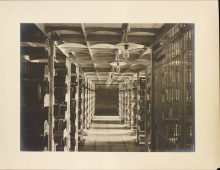You are here
Edward Livingston Papers
Related Topics
This collection and its sister collection, The Delafield Family Papers (also at
Princeton), were housed, until 1986, at Montgomery Place, Annandale-on-Hudson,
New York, the ancestral summer residence of many members of the Livingston and
Delafield families from circa 1805-1985. The Delafield family, especially John
Ross Delafield, 1875-1964, were avid genealogists who explored and augmented
their Livingston ancestor's papers as well as their Delafield antecedent's
records. The two collections arrived at Princeton in several different
arrangements, with collection parameters based on the family agencies that owned
the physical property. At Princeton, it was decided that the body of the
original materials would be split along family lines into two collections.
Researchers interested in the Livingston/Beekman line may also want to examine
the Delafield Family Papers for secondary sources, iconography, and genealogical
research on that branch of the family.Edward Livingston, 1764-1836, a key figure in local, national, and world
politics, is represented by correspondence, writings, property records,
financial records, and other manuscript and printed items. In general, the
arrangement of his papers is dictated by his varied career; however, a sizable
(56 box) correspondence series, arranged alphabetically, spans most of his adult
life. Livingston's correspondents comprise a veritable \who's who\ for the late
18th and early 19th centuries. Many of the Series Descriptions, later in this
guide, include lists of some of the frequent and well-known ones.The collection is especially strong in Livingston's work in the area of criminal
jurisprudence. A special series on the subject contains correspondence with
world-renowned legal theorists and jurists, topical writings and drafts, and a
collection of works on such issues as penal reform and the abolition of capital
punishment. There is also much documentary evidence of his role in the Jackson
administration as a supporter in the Congress and Senate, and later as secretary
of state and minister to France. A draft of the \Nullification Proclamation,\
written by Livingston for Jackson, is in the collection. The collection also
contains many legal records relating to both his law practice and private
affairs, including the 1803 \customs house funds scandal,\ his entanglement with
General James Wilkinson over the Burr controversy, and the split with Thomas
Jefferson over the New Orleans Batture.The women of the Livingston family - Margaret Beekman Livingston, 1724-1800
(Edward's mother); Janet Livingston Montgomery, 1743-1828 (Edward's sister);
Louise D'Avezac Livingston, circa 1781-1860 (Mrs. Edward Livingston); and
Coralie Livingston Barton, 1803-1873 (Edward and Louise's daughter) - are well
represented in the collection. Margaret and Janet, both widowed in mid-life,
became powerful landowners and matriarchs in the Hudson Valley, as well as
central figures in society. Their land records, financial documents, and
correspondence from the well-born and poor tenant alike are clear evidence of
their stature. Mrs. Livingston, too, was a well-respected hostess in whose
parlor intellectuals and political figures gathered. Coralie, once the belle of
New Orleans, was devoted to her father, and remained interested in her father's
work in criminal jurisprudence. Her efforts led to the re-issue of Edward
Livingston's works in 1873, and it was she who augmented his collection of works
on that subject after his death.There are small, but significant concentrations of records of
relatives-by-marriage, such as brother-in-law Auguste Davezac, 1780-1851,
diplomat to the Netherlands; Thomas Pennant Barton, 1803-1869, who joined
father-in-law Edward Livingston on the mission to Paris as secretary to the
legation; and General Richard Montgomery, 1738-1775, husband of Janet
Livingston, whose letters on the fatal march to Quebec are a particular
attraction of this collection.The collection contains a variety of ledgers and other financial records which
span almost three centuries; account books, rent books, day books, receipts, and
balance sheets abound. Many of these records relate to the Hudson Valley area,
notably lands that were passed down from Henry Beekman, 1688-1776, to Margaret
Beekman Livingston, and later to Janet Montgomery.The records of agent/surveyor John Cox, Jr., 1756-1825, are especially
interesting for their insight into the life of the laboring class of the young
republic. Cox worked for many of the Livingstons, surveying their properties,
drawing up deeds, leases, and rent agreements, and corresponding with tenants.
His work shows up throughout the papers of his employers as well-especially in
their financial and real estate records. The written and limned evidence of
Cox's career, coupled with surviving personal records and family correspondence,
present a well-rounded picture of a faithful employee and Colonial American
\everyman\ bent on self-improvement.Like Cox, the papers of Benjamin French are in contrast to the rest of the
collection. Their presence here is owed to a twist of fate; French's estate was
forfeited to the State of New York for suspected loyalism to the crown during
the Revolution, passed through several different hands, and finally settled with
Edward Livingston, who attempted to collect the outstanding debts due the late
merchant. These records provide insight into Albany-area business in the years
preceding and encompassing the start of the American Revolution. Divided into
series relating to claims of his estate and a general file of business records
(receipts, balance sheets, promissory notes, orders, and correspondence), these
documents paint an interesting picture of Hudson River Valley trade at the onset
of the Revolutionary struggle.Manuscripts of selected individuals in this collection, with the exception of
most of the financial and real estate records, have been indexed in the MASC
database of the Department of Special Collections, Princeton
University Library. The MASC index includes only literary and historical persons
whose lives have been chronicled in major biographical dictionaries such as
The Dictionary of American Biography.


